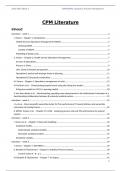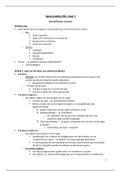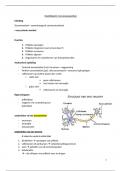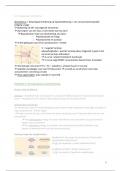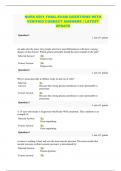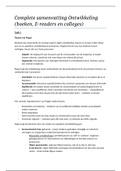2023-2024, Block 3 GW4018MV. Capacity & Process Management
CPM Literature
Inhoud
Literature – week 1...........................................................................................................................................3
I. Vissers – Chapter 1: Introduction...............................................................................................................4
Health Services Operations Management (HSOM)...................................................................................4
Defining HSOM.....................................................................................................................................4
Context of HSOM..................................................................................................................................5
Modelling & Design cycle..........................................................................................................................6
II. Vissers – Chapter 2: Health Service Operations Management..................................................................7
Services & Operations...............................................................................................................................7
Process or Chain.......................................................................................................................................9
Unit, Chain & Network perspectives.......................................................................................................10
Operational, tactical and strategic levels of planning..............................................................................11
Operational & Structural coordination....................................................................................................12
III. Vissers – Chapter 4: Operations management of units..........................................................................12
IV. De Bruin et al. – Dimensioning hospital wards using the Erlang loss model..........................................16
Erlang loss model (or M/G/c/c queuing model)......................................................................................18
V. Van Veen-Berkx et al. – Benchmarking operating room departments in the Netherlands: Evaluation of a
benchmarking collaborative between 8 university medical centres...........................................................21
Literature – week 2.........................................................................................................................................25
I. Lu & Lu – Does nonprofit ownership matter for firm performance? Financial distress and ownership
conversion of nursing homes......................................................................................................................25
II. EXTRA: Vissers et al. – Chapter 15: CASE – Analysing process and unit OM performance for general
surgery........................................................................................................................................................31
Literature – week 3.........................................................................................................................................32
I. Vissers et al. – Chapter 3. Data and modelling.........................................................................................32
Analytical models....................................................................................................................................36
Deterministic analytical models..........................................................................................................36
Stochastic analytical models...............................................................................................................37
Simulation models..................................................................................................................................37
Literature – week 4.........................................................................................................................................39
I. Vissers – Chapter 4 SEE WEEK 1..............................................................................................................39
II. Bordoloi & Fitzsimmons – Chapter 6: Statistical Process Control............................................................40
Control charts (X-, R-, p-).....................................................................................................................41
III. Bordoloi & Fitzsimmons – Chapter 7: Six Sigma.....................................................................................42
1
,2023-2024, Block 3 GW4018MV. Capacity & Process Management
IV. Olhager – The role of decoupling points in value chain management (p. 37 – 42).................................44
Literature – week 5.........................................................................................................................................46
I. Bohmer – Medicine’s service challenge: blending custom and standard care.........................................47
3 approaches to operations design.........................................................................................................48
(A & B) Separating Custom & Standard...............................................................................................48
(A) Separate & Select......................................................................................................................48
(B) Separate & Accommodate.........................................................................................................49
(D) Integrating Custom & Standard.....................................................................................................49
(C) Modularization..............................................................................................................................49
II. Kuntz, Scholtes & Sülz – Separate and concentrate: accounting for patient complexity in general
hospitals.....................................................................................................................................................51
2
,2023-2024, Block 3 GW4018MV. Capacity & Process Management
Literature – week 1
This first week, we do not expect that you have read all the lecture material before the lecture on Friday. You
may also read it after the lecture.
Vissers, Elkhuizen and Proudlove. Operations Management for Healthcare. Routledge, London, 2022.
Chapter 1
Vissers, Elkhuizen and Proudlove. Operations Management for Healthcare. Routledge, London, 2022.
Chapter 2
Vissers, Elkhuizen and Proudlove. Operations Management for Healthcare. Routledge, London, 2022.
Chapter 4
De Bruin, AM,· Bekker, R, Van Zanten, L., Koole, GM. 2010. Dimensioning hospital wards using the Erlang
loss model. Ann Oper Res (2010) 178: 23–43. DOI 10.1007/s10479-009-0647-8
Veen van-Berkx E; Korne de, DF. Olivier, OS; Bal RA; Kazemier G. (2016) "Benchmarking operating room
departments in the Netherlands: Evaluation of a benchmarking collaborative between eight university
medical centres", Benchmarking: An International Journal, Vol. 23 Issue: 5, pp.1171-1192, DOI
10.1108/BIJ-04-2014-0035
3
, 2023-2024, Block 3 GW4018MV. Capacity & Process Management
I. Vissers – Chapter 1: Introduction
Health Services Operations Management (HSOM)
Defining HSOM
The term ‘operations management’ (OM) refers to the planning and control of the processes that transform
inputs into outputs. This definition also applies to Health Services Operations Management (HSOM).
Example: the individual doctor/patient consultation. Input = a patient with a request for healthcare. Output =
diagnosis, referral or treatment. The resources that must be managed to transform inputs into outputs are those
associated with the care provided by the doctor (e.g. time, medical tools, etc.). HSOM needs to ensure that
adequate resources are in place on time to prove a service for the patient, without them having to wait too long.
HSOM focuses on the individual provider that produces a health service and on the tasks involved to
produce this service in such a way that service standards are met, whilst also avoiding wasteful provision of
excessive resources. The ‘individual’ provider may be e.g. one doctor, a hospital department, a hospital or a
network of hospitals, community-based services; at each different level both the scale and scope of the
processes and resources to be planned and controlled increase, as does the complexity of the OM task.
Patient demand for care is the key input which influences the planning and control of the resources
required to transform inputs into outputs. However, as Figure 1.1 illustrates, other ‘inputs’ influence both
the types and levels of patient demand and the ways in which the hospital delivers care.
Figure 1.1 highlights 3 generic processes for transforming inputs into outputs:
Clinical processes: these are the primary processes in which the transformations take place.
Management processes: take care of the planning and control of resources required for the diagnoses
and treatment of patients.
o At the operational level: individual patients are scheduled for appointments or an admission
requiring outpatient clinic resources or operating theatre resources and a bed in a ward.
o At the tactical level: availability of resources for the coming weeks is checked and at the
strategic level, checks are made on the amounts of resources required for the longer term.
Ancillary processes: are needed to support the general functioning of the hospital.
Finally, Figure 1.1 illustrates the outputs of the OM processes that must be monitored:
Health status markers (e.g. mortality rates, levels of morbidity and disability)
Client experience markers
Use of resources: to monitor efficiency (e.g. patient lengths of stay, response times of ancillary support
services, resource utilization) and effectiveness (e.g. use of ‘appropriate’ or ‘modern’ procedures).
4
CPM Literature
Inhoud
Literature – week 1...........................................................................................................................................3
I. Vissers – Chapter 1: Introduction...............................................................................................................4
Health Services Operations Management (HSOM)...................................................................................4
Defining HSOM.....................................................................................................................................4
Context of HSOM..................................................................................................................................5
Modelling & Design cycle..........................................................................................................................6
II. Vissers – Chapter 2: Health Service Operations Management..................................................................7
Services & Operations...............................................................................................................................7
Process or Chain.......................................................................................................................................9
Unit, Chain & Network perspectives.......................................................................................................10
Operational, tactical and strategic levels of planning..............................................................................11
Operational & Structural coordination....................................................................................................12
III. Vissers – Chapter 4: Operations management of units..........................................................................12
IV. De Bruin et al. – Dimensioning hospital wards using the Erlang loss model..........................................16
Erlang loss model (or M/G/c/c queuing model)......................................................................................18
V. Van Veen-Berkx et al. – Benchmarking operating room departments in the Netherlands: Evaluation of a
benchmarking collaborative between 8 university medical centres...........................................................21
Literature – week 2.........................................................................................................................................25
I. Lu & Lu – Does nonprofit ownership matter for firm performance? Financial distress and ownership
conversion of nursing homes......................................................................................................................25
II. EXTRA: Vissers et al. – Chapter 15: CASE – Analysing process and unit OM performance for general
surgery........................................................................................................................................................31
Literature – week 3.........................................................................................................................................32
I. Vissers et al. – Chapter 3. Data and modelling.........................................................................................32
Analytical models....................................................................................................................................36
Deterministic analytical models..........................................................................................................36
Stochastic analytical models...............................................................................................................37
Simulation models..................................................................................................................................37
Literature – week 4.........................................................................................................................................39
I. Vissers – Chapter 4 SEE WEEK 1..............................................................................................................39
II. Bordoloi & Fitzsimmons – Chapter 6: Statistical Process Control............................................................40
Control charts (X-, R-, p-).....................................................................................................................41
III. Bordoloi & Fitzsimmons – Chapter 7: Six Sigma.....................................................................................42
1
,2023-2024, Block 3 GW4018MV. Capacity & Process Management
IV. Olhager – The role of decoupling points in value chain management (p. 37 – 42).................................44
Literature – week 5.........................................................................................................................................46
I. Bohmer – Medicine’s service challenge: blending custom and standard care.........................................47
3 approaches to operations design.........................................................................................................48
(A & B) Separating Custom & Standard...............................................................................................48
(A) Separate & Select......................................................................................................................48
(B) Separate & Accommodate.........................................................................................................49
(D) Integrating Custom & Standard.....................................................................................................49
(C) Modularization..............................................................................................................................49
II. Kuntz, Scholtes & Sülz – Separate and concentrate: accounting for patient complexity in general
hospitals.....................................................................................................................................................51
2
,2023-2024, Block 3 GW4018MV. Capacity & Process Management
Literature – week 1
This first week, we do not expect that you have read all the lecture material before the lecture on Friday. You
may also read it after the lecture.
Vissers, Elkhuizen and Proudlove. Operations Management for Healthcare. Routledge, London, 2022.
Chapter 1
Vissers, Elkhuizen and Proudlove. Operations Management for Healthcare. Routledge, London, 2022.
Chapter 2
Vissers, Elkhuizen and Proudlove. Operations Management for Healthcare. Routledge, London, 2022.
Chapter 4
De Bruin, AM,· Bekker, R, Van Zanten, L., Koole, GM. 2010. Dimensioning hospital wards using the Erlang
loss model. Ann Oper Res (2010) 178: 23–43. DOI 10.1007/s10479-009-0647-8
Veen van-Berkx E; Korne de, DF. Olivier, OS; Bal RA; Kazemier G. (2016) "Benchmarking operating room
departments in the Netherlands: Evaluation of a benchmarking collaborative between eight university
medical centres", Benchmarking: An International Journal, Vol. 23 Issue: 5, pp.1171-1192, DOI
10.1108/BIJ-04-2014-0035
3
, 2023-2024, Block 3 GW4018MV. Capacity & Process Management
I. Vissers – Chapter 1: Introduction
Health Services Operations Management (HSOM)
Defining HSOM
The term ‘operations management’ (OM) refers to the planning and control of the processes that transform
inputs into outputs. This definition also applies to Health Services Operations Management (HSOM).
Example: the individual doctor/patient consultation. Input = a patient with a request for healthcare. Output =
diagnosis, referral or treatment. The resources that must be managed to transform inputs into outputs are those
associated with the care provided by the doctor (e.g. time, medical tools, etc.). HSOM needs to ensure that
adequate resources are in place on time to prove a service for the patient, without them having to wait too long.
HSOM focuses on the individual provider that produces a health service and on the tasks involved to
produce this service in such a way that service standards are met, whilst also avoiding wasteful provision of
excessive resources. The ‘individual’ provider may be e.g. one doctor, a hospital department, a hospital or a
network of hospitals, community-based services; at each different level both the scale and scope of the
processes and resources to be planned and controlled increase, as does the complexity of the OM task.
Patient demand for care is the key input which influences the planning and control of the resources
required to transform inputs into outputs. However, as Figure 1.1 illustrates, other ‘inputs’ influence both
the types and levels of patient demand and the ways in which the hospital delivers care.
Figure 1.1 highlights 3 generic processes for transforming inputs into outputs:
Clinical processes: these are the primary processes in which the transformations take place.
Management processes: take care of the planning and control of resources required for the diagnoses
and treatment of patients.
o At the operational level: individual patients are scheduled for appointments or an admission
requiring outpatient clinic resources or operating theatre resources and a bed in a ward.
o At the tactical level: availability of resources for the coming weeks is checked and at the
strategic level, checks are made on the amounts of resources required for the longer term.
Ancillary processes: are needed to support the general functioning of the hospital.
Finally, Figure 1.1 illustrates the outputs of the OM processes that must be monitored:
Health status markers (e.g. mortality rates, levels of morbidity and disability)
Client experience markers
Use of resources: to monitor efficiency (e.g. patient lengths of stay, response times of ancillary support
services, resource utilization) and effectiveness (e.g. use of ‘appropriate’ or ‘modern’ procedures).
4

